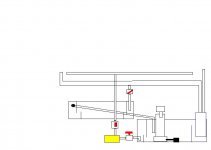Need help with Microbubbles
I have been working for 3 weeks to try and get rid of the microbubbles in my new tank. I have a 180 AGA RR, 1 1/4 durso's to 1" drain to the sump and fuge. I have a blueline HD 40X external pump for the return with 1" out of the sump to the pump. 1" out of the pump to a 1" to 3/4" tee, this feeds the 3/4" return lines going up each overflow, which is then attached to a spray bar across the entire back of the tank. I do the a 90 degree elbow on the intake side of the pump, inside the sump facing down.
I have put filter floss material, and filter sponge in front of the last two baffles in the sump, trying to get the last of the microbubbles. The causes the pump to suck more air, due to the decreased flow through the sump. If I restrict the pump using th ball valvles, it helps but doesn't eliminate the problem.
I have two ideas I might try, wanted to get some expert advice first. The two files labeled option1 and option2 are my ideas.
Basicaly I am thinking about adding more distance between the sump and the return pump inlet. Let me know wat you think.
Thanks
I have been working for 3 weeks to try and get rid of the microbubbles in my new tank. I have a 180 AGA RR, 1 1/4 durso's to 1" drain to the sump and fuge. I have a blueline HD 40X external pump for the return with 1" out of the sump to the pump. 1" out of the pump to a 1" to 3/4" tee, this feeds the 3/4" return lines going up each overflow, which is then attached to a spray bar across the entire back of the tank. I do the a 90 degree elbow on the intake side of the pump, inside the sump facing down.
I have put filter floss material, and filter sponge in front of the last two baffles in the sump, trying to get the last of the microbubbles. The causes the pump to suck more air, due to the decreased flow through the sump. If I restrict the pump using th ball valvles, it helps but doesn't eliminate the problem.
I have two ideas I might try, wanted to get some expert advice first. The two files labeled option1 and option2 are my ideas.
Basicaly I am thinking about adding more distance between the sump and the return pump inlet. Let me know wat you think.
Thanks









